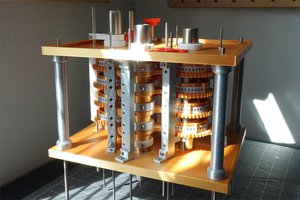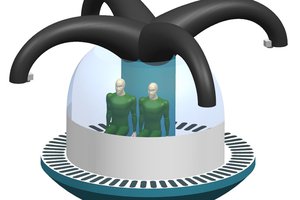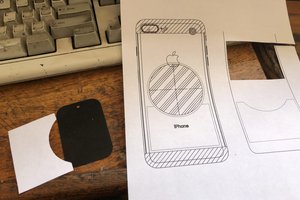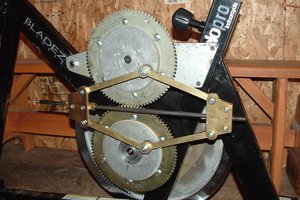The essence of the utility model is explained by the following schematic images:
Fig. 1 is a schematic representation of the general front view of a modular airship , which shows an apparatus consisting of spherical bodies filled with gas or vacuum – 1, connecting parts – 2, an air propeller – 3 on a gondola – 4.
And as an embodiment, simultaneously in this figure, spherical bodies of a hybrid nature are shown, when 5 - the inner shell of a spherical body with a vacuum, is surrounded by another layer 6 - the outer shell, inside which is filled with helium or hydrogen gas.
Fig. 2 - schematic representation of the general side view of the modular airship.
The spherical bodies 1 are attached to each other and to the gondola by means of connecting parts 2, which are cylindrical rubber or metal tubes, and which in turn provide space for the expansion of the shells 1 to the required diameter of the shells 1 and prevent excessive loads on the central sling during their expansion. In each tier there are three shells, in order to avoid contact of the shells 1 with the central sling. The proposed airship is assembled from shells already filled and hermetically sealed or equipped with individual valves.
For example, mass-produced rubber latex radiosonde shells can be used as shells. In hybrid spherical bodies, the innermost shells have a vacuum inside, the outer ones are filled with helium or hydrogen, their weight is most often from 375 to 900 g, the circumference with normal filling is from 470 to 600 cm, the diameter of the gap between the spherical bodies is up to 13 meters.
 Śρițąmén Ťuŗonïγ
Śρițąmén Ťuŗonïγ

 MechRedPanda
MechRedPanda

 Pablo E. Untroib
Pablo E. Untroib
 Joseph Lavoie
Joseph Lavoie
This idea was originally submitted as a patent application in Uzbekistan, but it was rejected. Now, I'm hoping that someone else can continue developing it further. If you'd like to support me in my programming projects, please check out my GoFundMe page: https://gofund.me/cbcf7a39.